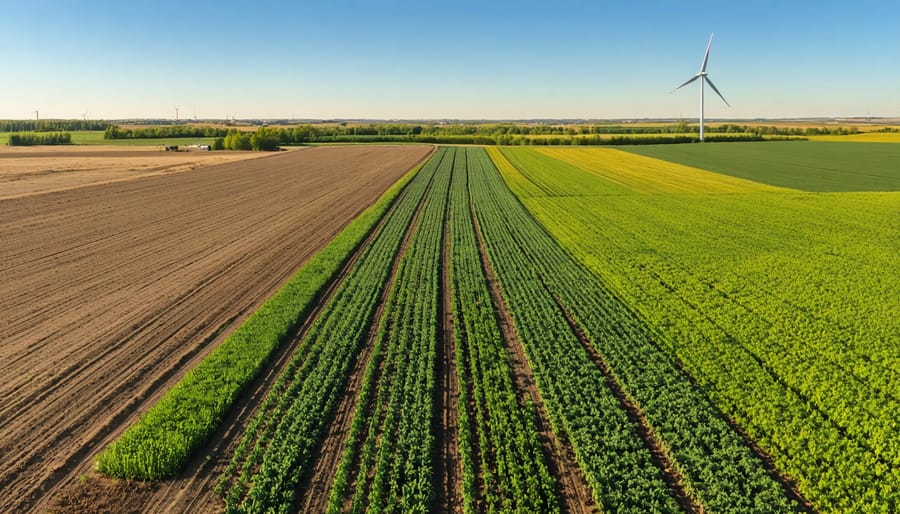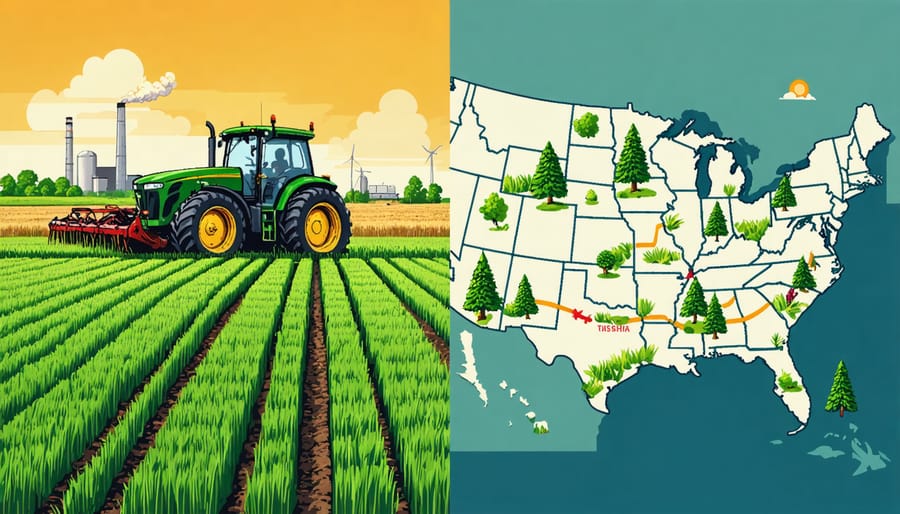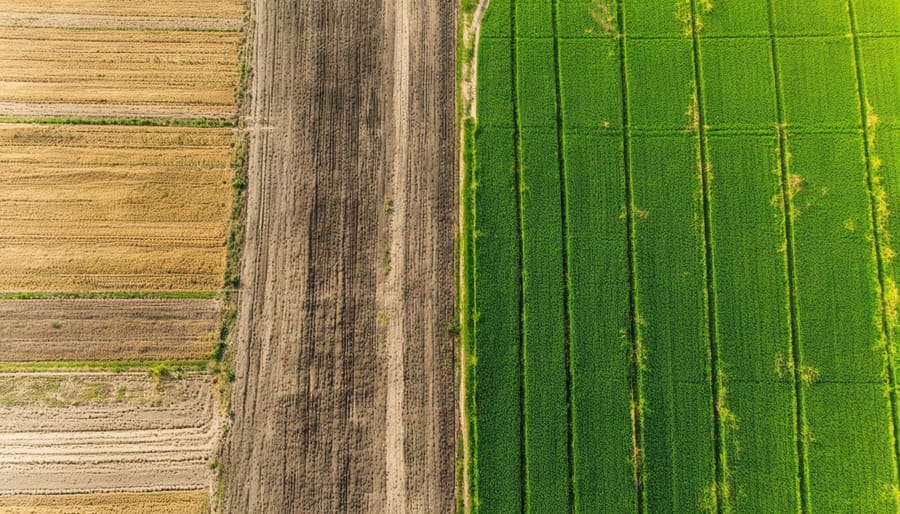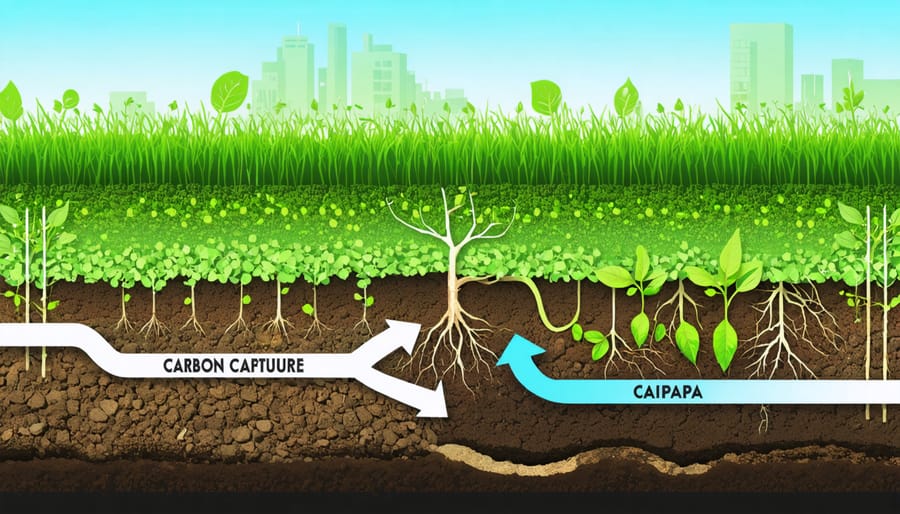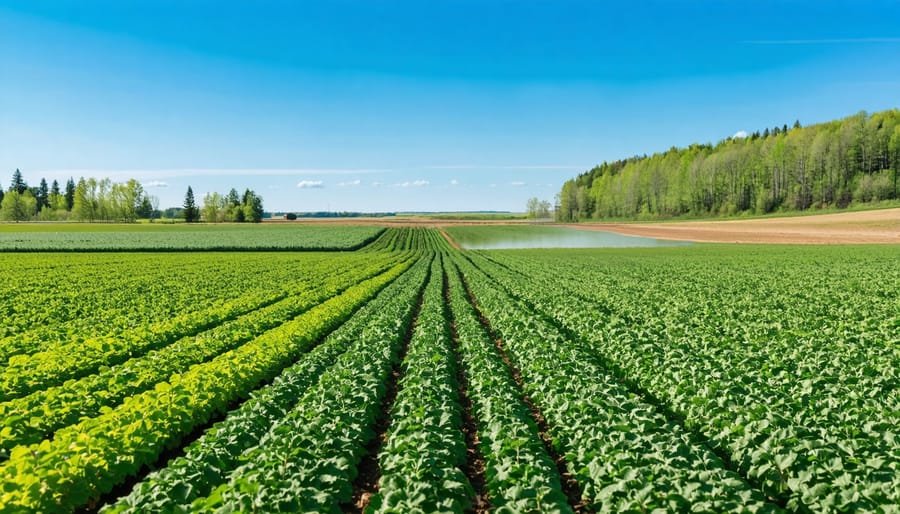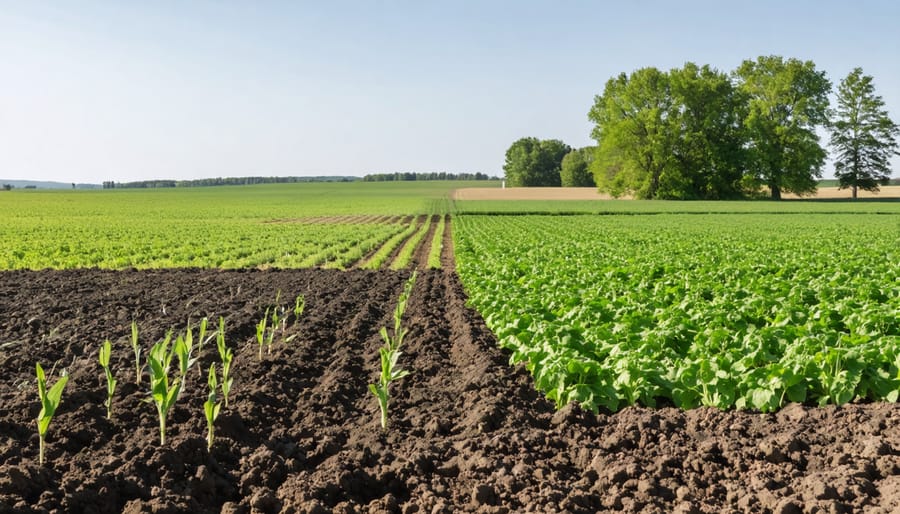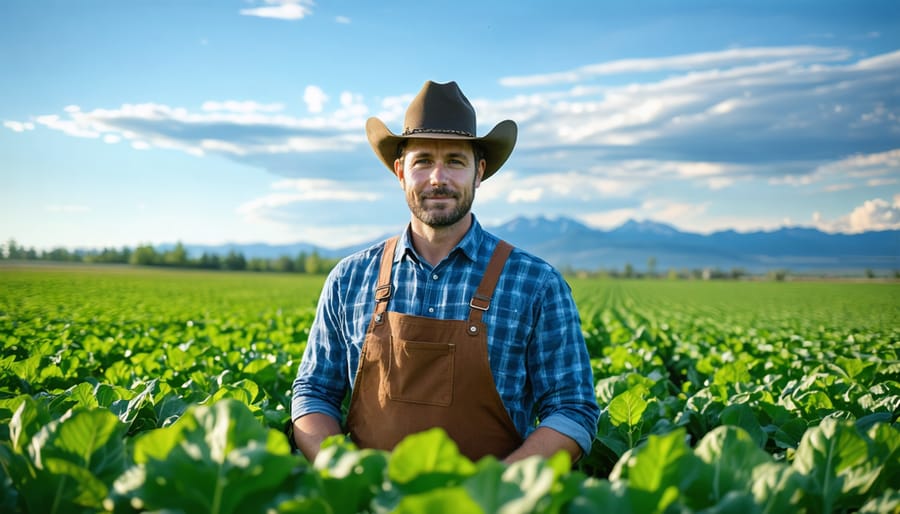Transforming Canada’s agricultural landscape demands bold action as farmers lead the charge toward a low-carbon future. Through innovative carbon sequestration practices, Alberta’s farming community is pioneering practical solutions that merge profitability with environmental stewardship. The transition to a low-carbon economy represents more than environmental responsibility—it opens new revenue streams through carbon credits, enhanced soil productivity, and premium market access for sustainably produced crops.
Recent data from Alberta carbon farming projects demonstrates that farms implementing regenerative practices have reduced operational costs by 15-20% while increasing soil organic matter by up to 2% over five years. This economic transformation isn’t just theoretical—it’s happening in fields across the province, where farmers are proving that climate-smart agriculture strengthens both environmental and financial resilience.
As global markets increasingly reward sustainable production methods, Alberta farmers are positioning themselves at the forefront of agricultural innovation, creating a blueprint for low-carbon farming that maintains productivity while building natural capital for future generations.
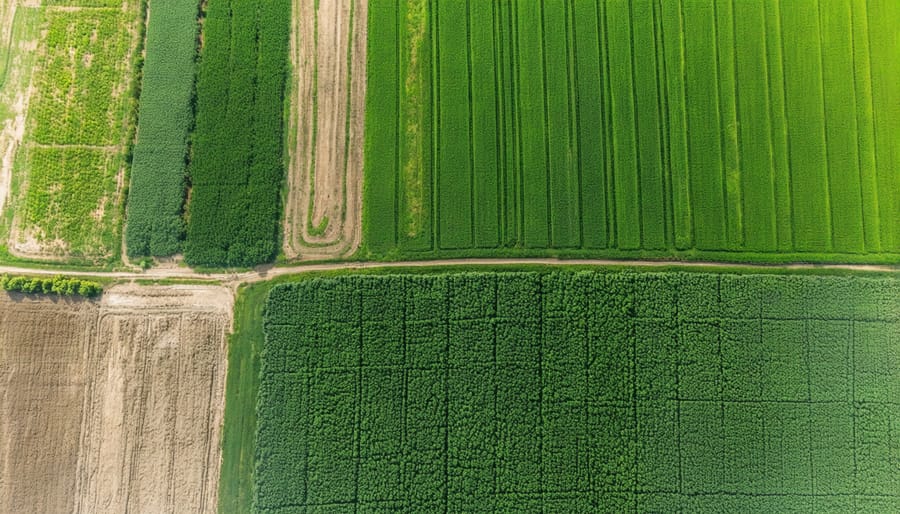
The Business Case for Soil Carbon Projects
Carbon Credit Markets in Alberta
Alberta’s carbon market has emerged as a pioneer in Canada’s transition to a low-carbon economy, offering farmers unique soil carbon credit opportunities through the province’s regulated offset system. The current carbon price in Alberta stands at $65 per tonne (2023), with planned increases to reach $170 per tonne by 2030, creating significant potential for agricultural producers.
The system operates through two main channels: the Technology Innovation and Emissions Reduction (TIER) program for large industrial emitters, and the voluntary offset market where farmers can participate. Through these markets, farmers can generate carbon credits by implementing approved protocols such as conservation tillage, improved grazing management, and nitrogen optimization.
Local aggregators help farmers navigate the verification process, typically taking 10-20% of credit value as service fees. Most agricultural projects in Alberta generate between 0.2 to 0.5 tonnes of carbon credits per hectare annually, depending on practices and soil conditions.
To participate, farmers must document their baseline emissions, implement verified carbon reduction practices, and maintain detailed records for annual third-party verification. While the initial paperwork may seem daunting, many producers report that the long-term benefits – both environmental and financial – make the effort worthwhile.
Success stories from early adopters show that combining multiple practices can maximize returns while building soil health and farm resilience.
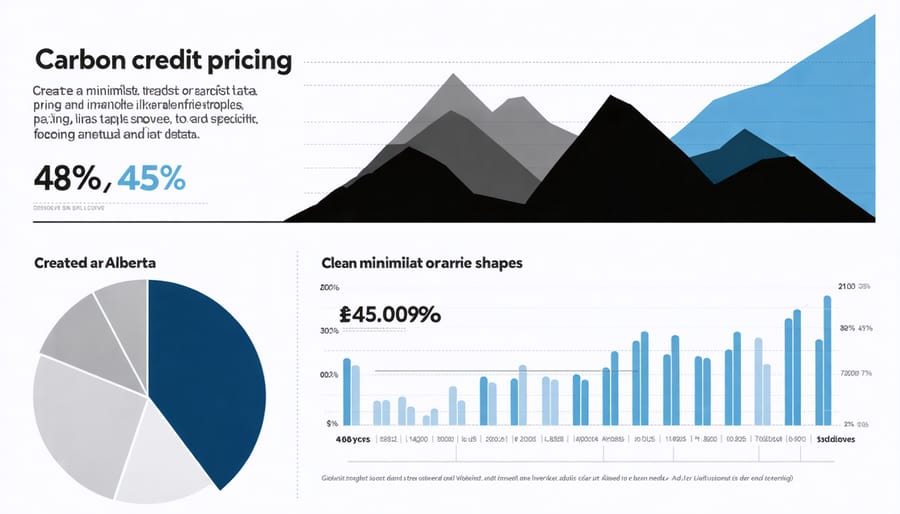
Revenue Streams and ROI Analysis
Transitioning to a low-carbon economy opens up multiple revenue streams for Alberta farmers. Based on current market trends, carbon credit trading can generate between $15-30 per tonne of CO2 equivalent stored, with prices expected to rise as carbon markets mature. When evaluating carbon storage investment considerations, farmers typically see returns within 3-5 years of implementing sustainable practices.
Primary revenue sources include:
– Direct carbon credit sales through Alberta’s emission offset system
– Premium pricing for certified low-carbon agricultural products
– Government incentives and grants for sustainable farming practices
– Reduced input costs through improved soil health
Local success stories show impressive ROI figures. The Peterson family farm in Red Deer County reported a 15% increase in net revenue after implementing regenerative practices, while saving approximately $75/hectare on fertilizer costs. Similar results were achieved by the Mountain View Collective, where twelve farms averaged 20% cost reduction in the first two years.
Remember that revenue potential varies based on soil type, current farming practices, and market conditions. Working with local agricultural extension services can help develop a personalized ROI projection that accounts for your specific circumstances and goals.
Risk Management Strategies
Market Volatility Protection
As carbon markets continue to evolve, protecting your farm operation against price volatility is crucial for long-term success. Many Alberta farmers have found success by implementing a diverse range of hedging strategies to manage carbon credit price fluctuations.
One effective approach is participating in long-term carbon credit contracts, which lock in prices for multiple years. Several local agricultural cooperatives offer these arrangements, providing stability and predictable revenue streams. For example, the Central Alberta Carbon Coalition has helped members secure five-year contracts at guaranteed minimum prices.
Forward selling a portion of your carbon credits while keeping some in reserve allows you to benefit from both price stability and potential market upside. Consider the 60-40 rule many successful carbon farmers follow: selling 60% of credits through forward contracts while holding 40% for spot market opportunities.
Insurance products specifically designed for carbon farming are emerging in the Canadian market. These products can protect against both price drops and verification failures, offering an additional layer of security for your carbon project investment.
Diversifying your carbon farming practices is another reliable strategy. By implementing multiple carbon sequestration methods – such as cover cropping, reduced tillage, and rotational grazing – you create various streams of carbon credits, reducing your exposure to market fluctuations in any single practice category.
Working with established carbon credit aggregators can also help buffer market volatility through their larger trading volumes and market expertise.
Project Implementation Safeguards
To ensure successful implementation of low-carbon farming projects, several key safeguards need to be in place. Regular soil testing forms the foundation of your project monitoring, with samples taken at consistent intervals throughout the year to track carbon levels and overall soil health. We recommend working with certified soil testing laboratories in Alberta that understand local soil conditions.
Maintaining detailed records is crucial. Document all farming practices, including tillage methods, cover crop plantings, and fertilizer applications. This documentation not only helps track progress but also supports carbon credit verification processes.
Implement buffer zones between different management areas to prevent cross-contamination and maintain the integrity of your carbon farming practices. These zones also serve as wildlife corridors, supporting biodiversity on your farm.
Risk management strategies should include diverse crop rotations to maintain soil structure and organic matter levels. Consider incorporating drought-resistant varieties suitable for Alberta’s climate to ensure project resilience during challenging weather conditions.
Regular consultation with agricultural extension services and soil health specialists helps identify potential issues before they become problems. Many successful Alberta farmers participate in peer-learning groups, sharing experiences and solutions for common challenges in carbon farming implementation.
Remember to balance carbon sequestration goals with overall farm productivity. Start with smaller pilot areas before scaling up, allowing you to refine your approach while minimizing risk to your operation’s bottom line.
Legal and Compliance Considerations
When transitioning to low-carbon practices, Alberta farmers must navigate several regulatory frameworks and compliance requirements. The Carbon Offset System in Alberta operates under the Technology Innovation and Emissions Reduction (TIER) Regulation, which sets specific guidelines for carbon credit generation and verification.
Before starting any carbon offset project, farmers should ensure they have clear documentation of land ownership or lease agreements. These documents are essential for establishing carbon rights and participating in carbon markets. It’s also crucial to maintain detailed records of farming practices, including inputs, tillage methods, and crop rotations, as these will be required for verification purposes.
Working with a qualified verification body is mandatory for carbon credit projects in Alberta. These third-party verifiers must be accredited by the Standards Council of Canada or the American National Standards Institute. They’ll review your documentation and confirm that your practices meet the protocol requirements.
Conservation easements and carbon rights agreements should be carefully reviewed by legal professionals familiar with agricultural law. These agreements often extend for multiple years, so understanding your long-term obligations is essential. Many successful Alberta farmers work with agricultural lawyers who specialize in carbon markets to ensure their interests are protected.
Remember that compliance requirements may change as carbon markets evolve. Staying connected with local agricultural organizations and attending workshops can help you stay current with regulatory updates and new opportunities in the low-carbon economy.
Success Stories from Alberta’s Carbon Pioneers
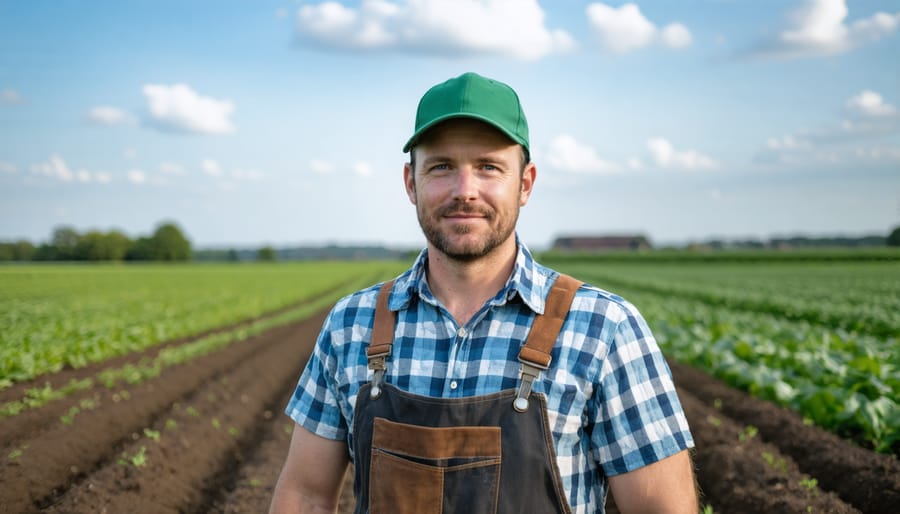
Red Deer Valley Success Story
Located in central Alberta, the Red Deer Valley region has emerged as a shining example of successful low-carbon transition in agriculture. The Miller family farm, a 2,000-hectare operation run by third-generation farmers Sarah and James Miller, showcases how traditional farming practices can evolve to meet modern environmental challenges while maintaining profitability.
In 2019, the Millers implemented a comprehensive carbon reduction strategy that included no-till farming practices, cover crop rotation, and precision agriculture technology. Within three years, they documented a 45% reduction in their carbon footprint while increasing their soil organic matter by 2.3%.
“The transition wasn’t just about environmental benefits,” explains Sarah Miller. “We’ve seen our input costs decrease by approximately $75 per hectare annually, primarily through reduced fuel consumption and more efficient fertilizer use.” The farm’s yield has remained stable, and in some fields, productivity has actually improved due to enhanced soil health.
The Millers’ success attracted attention from neighboring farms, leading to the formation of the Red Deer Valley Carbon Coalition, a group of 15 local farmers who share knowledge and resources. The coalition has collectively sequestered an estimated 12,000 tonnes of carbon dioxide equivalent since 2020, while generating additional revenue through carbon credit programs.
Local agricultural extension officer Mark Thompson notes, “The Miller farm demonstrates that economic prosperity and environmental stewardship can go hand in hand. Their approach has created a blueprint for other Alberta farmers looking to transition to low-carbon practices.”
Lessons from Early Adopters
Early adopters of carbon farming in Alberta have paved the way with valuable insights that can benefit those just starting their journey. Tom Anderson, a third-generation farmer from Lacombe County, emphasizes the importance of starting small and scaling gradually. “We began with just 40 hectares implementing regenerative farming practices, which allowed us to learn and adjust without overwhelming our resources,” he shares.
Sarah Mitchell, who transitioned her 200-hectare farm near Red Deer five years ago, highlights the value of detailed record-keeping from day one. Her experience shows that maintaining comprehensive soil testing data and management records not only helps track progress but proves invaluable when applying for carbon credits.
Common advice from successful adopters includes:
– Building strong relationships with soil health experts and agricultural extension services
– Joining local farmer networks to share experiences and resources
– Investing in soil testing and monitoring equipment gradually
– Maintaining flexibility in implementation strategies
– Starting with the most responsive fields first
Many early adopters also stress the importance of viewing the transition as a long-term investment. “The first two years were challenging,” notes James Wilson from Mountain View County, “but by year three, we saw significant improvements in soil structure and reduced input costs.”
These pioneers consistently emphasize that success comes from balancing immediate economic needs with long-term sustainability goals. Their experiences show that careful planning, community support, and patience are key ingredients in a successful transition to low-carbon farming.
As we’ve explored throughout this article, soil carbon projects represent a significant opportunity for Canadian farmers to contribute to climate change mitigation while potentially creating new revenue streams. The transition to a low-carbon economy doesn’t have to be overwhelming – it can be approached step by step, with support from your local agricultural community and experts.
For Alberta farmers interested in getting started with soil carbon projects, we recommend beginning with a soil health assessment to establish your baseline. Connect with your local agricultural extension office or soil conservation society to learn about available resources and support programs. Many successful projects in our region started with simple changes like reducing tillage or implementing cover crops before expanding to more comprehensive carbon farming practices.
Remember that you’re not alone in this journey. Our agricultural community has a strong history of innovation and adaptation. Numerous farmers across Alberta have already successfully integrated carbon farming practices, proving that environmental stewardship and profitable farming can go hand in hand. The key is to start small, measure your progress, and scale up based on your farm’s unique conditions and capabilities.
Next steps to consider include:
– Attending workshops and field days focused on soil carbon management
– Connecting with experienced carbon farmers in your area
– Researching available carbon credit programs and certification requirements
– Consulting with agricultural advisors about specific practices suitable for your operation
– Developing a timeline for implementing changes that works with your current farming schedule
As carbon markets continue to evolve and new opportunities emerge, staying informed and connected with your farming community will be crucial. Consider joining local agricultural associations or online forums where farmers share their experiences with carbon projects. The transition to a low-carbon economy is a collaborative effort, and your participation helps build a more resilient and sustainable future for Canadian agriculture.
Take that first step today – whether it’s reaching out to your local agricultural office or talking with neighboring farmers who have experience with carbon projects. Your journey toward carbon farming can start with just one change, leading to both environmental and economic benefits for your operation.

